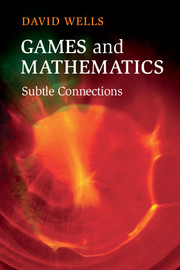Book contents
- Frontmatter
- Contents
- Acknowledgements
- Part I Mathematical Recreations and Abstract Games
- Part II Mathematics: game-like, scientific and perceptual
- 6 Game-like mathematics
- 7 Euclid and the rules of his geometrical game
- 8 New concepts and new objects
- 9 Convergent and divergent series
- 10 Mathematics becomes game-like
- 11 Mathematics as science
- 12 Numbers and sequences
- 13 Computers and mathematics
- 14 Mathematics and the sciences
- 15 Minimum paths: elegant simplicity
- 16 The foundations: perception, imagination, insight
- 17 Structure
- 18 Hidden structure, common structure
- 19 Mathematics and beauty
- 20 Origins: formality in the everyday world
- References
- Index
16 - The foundations: perception, imagination, insight
Published online by Cambridge University Press: 05 November 2012
- Frontmatter
- Contents
- Acknowledgements
- Part I Mathematical Recreations and Abstract Games
- Part II Mathematics: game-like, scientific and perceptual
- 6 Game-like mathematics
- 7 Euclid and the rules of his geometrical game
- 8 New concepts and new objects
- 9 Convergent and divergent series
- 10 Mathematics becomes game-like
- 11 Mathematics as science
- 12 Numbers and sequences
- 13 Computers and mathematics
- 14 Mathematics and the sciences
- 15 Minimum paths: elegant simplicity
- 16 The foundations: perception, imagination, insight
- 17 Structure
- 18 Hidden structure, common structure
- 19 Mathematics and beauty
- 20 Origins: formality in the everyday world
- References
- Index
Summary
Perception is a puzzle. We think of visual perception because we use our eyes so much though we perceive through all our senses. But we also say, ‘Can you see the next move?’ or ‘Can you spot the next move?’ which often means ‘Can you work it out?’ We also ask, ‘Do you see what I mean?’ which happens to be the commonest use of ‘see’ in the English language – and it's not about seeing, but about understanding!
Psychologists tell us that perception is an active and neurologically complex process. We see nothing instantly, only in real time. As we look at a geometrical diagram our eyes pick out particular features that are already there on the paper (or the computer screen) but we may also ‘see’ lines or circles or points that are not yet there. They are potential – we could add them if we chose to do so. The Greeks were keen on such constructions and often used them in their proofs. Indeed, many proofs would be impossible without them.
So we see what is actually there, and we ‘see’ or imagine what might be, emphasising how active mathematics is. Indeed, we can sometimes ‘see’ what would happen if the parts of the diagram started moving around. We see, in our mind’s eye, the effect of a transformation. Computer graphics can create this movement for you but this can be dangerous: a machine which replaces your brain may stop your brain working, a disaster because maths is an imaginative activity that needs an active brain.
- Type
- Chapter
- Information
- Games and MathematicsSubtle Connections, pp. 170 - 183Publisher: Cambridge University PressPrint publication year: 2012



